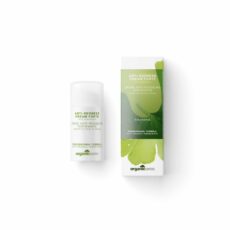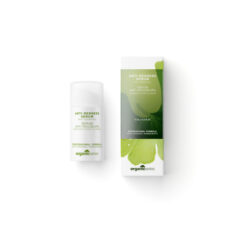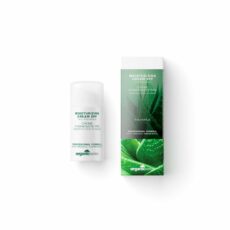Anti redness skincare
Anti Redness Skincare: Autumn is a wonderful season that brings a crisp, cool breeze, colorful falling leaves, and the cozy sensation of wrapping up in warm clothes. However, with these joys come significant challenges for your skin, especially if you’re prone to redness and sensitivity. The sudden shift in temperature, lower humidity levels, and exposure to harsh winds can leave your skin feeling irritated, dry, and visibly red.
For many people, this time of year can be a period where their skin becomes more reactive, leading to unwanted flare-ups of redness and inflammation. This is why autumn is the ideal time to reassess and revamp your skincare routine with a focus on anti-redness treatments. Adapting to the new season’s environmental changes and adopting a regimen that prioritizes hydration, calming ingredients, and protection from the elements can make all the difference.
Whether your skin is naturally sensitive, prone to rosacea, or you’ve noticed an increase in redness due to seasonal transitions, these 14 detailed tips will guide you toward a healthier, more radiant complexion. Let’s explore how you can maintain glowing, calm skin this autumn by making simple yet impactful adjustments to your skincare routine.
1. Use a Gentle Cleanser
Cleansing is the foundation of any good skincare routine, but it becomes even more critical when you’re dealing with redness and sensitivity. During the autumn months, your skin’s protective barrier is often compromised by colder temperatures and drier air. Using a harsh or stripping cleanser can further weaken this barrier, leading to even more redness and irritation.
Switch to a gentle, sulfate-free cleanser that is specifically designed for sensitive skin. These cleansers usually contain hydrating and soothing ingredients like aloe vera, chamomile, and glycerin, which not only clean the skin but also nourish and calm it. The goal is to remove impurities without upsetting your skin’s natural oils. If your skin feels tight or dry after cleansing, it’s a sign that you’re using something too harsh. In autumn, it’s all about being kind to your skin and preserving its moisture balance.
2. Avoid Hot Water
As the temperatures drop, nothing feels better than a hot shower. However, using hot water on your face can be a major culprit behind increased redness and irritation. Hot water strips your skin of essential oils and can cause blood vessels to dilate, making redness more pronounced. This effect is even more damaging during autumn when your skin is already battling dry, cool air.
To prevent this, always wash your face with lukewarm water. It may not feel as soothing on a chilly morning, but it’s much gentler on your skin and will help keep redness at bay. Lukewarm water ensures that your skin remains calm, while also allowing your skincare products to be absorbed more effectively. By simply adjusting the temperature of the water you use, you can make a big difference in how your skin reacts throughout the season.
3. Hydrate, Hydrate, Hydrate
One of the biggest reasons for redness in autumn is the loss of moisture in the skin. The drop in humidity combined with indoor heating can severely dehydrate your skin, making it prone to irritation and redness. To combat this, you need to keep your skin well-hydrated throughout the season. Hydration is the key to maintaining a healthy skin barrier, which acts as your skin’s first line of defense against environmental stressors.
Using a rich, hydrating moisturizer with ingredients like hyaluronic acid, glycerin, and ceramides will help lock in moisture and keep your skin plump and calm. Hyaluronic acid, in particular, is a powerhouse hydrator that draws moisture from the air and binds it to your skin. Meanwhile, ceramides help rebuild and strengthen your skin’s barrier, making it less susceptible to redness and irritation. Make sure to apply your moisturizer on damp skin to seal in as much hydration as possible.
4. Incorporate Anti-Redness Serums
If you struggle with persistent redness, adding an anti-redness serum to your routine can be a game-changer. Serums are lightweight, highly concentrated formulations that deliver potent active ingredients deep into the skin. Look for serums that contain calming and anti-inflammatory ingredients like niacinamide, green tea extract, or centella asiatica. These ingredients are known for their ability to soothe irritated skin, reduce inflammation, and promote an even skin tone.
Niacinamide (vitamin B3) is particularly effective at reducing redness by strengthening the skin’s barrier and improving moisture retention. It also helps to reduce the appearance of enlarged pores, another common issue for those with sensitive or redness-prone skin. Apply your serum after cleansing and before moisturizing for maximum benefits. Over time, consistent use of an anti-redness serum can significantly reduce the frequency and severity of redness flare-ups.
5. Always Apply Sunscreen
Even though the sun feels less intense in autumn, harmful UV rays are still present and can trigger or worsen skin redness. UVA rays, in particular, penetrate deep into the skin and contribute to premature aging, hyperpigmentation, and skin sensitivity. Protecting your skin with sunscreen should remain a non-negotiable part of your skincare routine, no matter the season.
Choose a broad-spectrum sunscreen with an SPF of at least 30, and look for formulations that are specifically designed for sensitive or redness-prone skin. Physical sunscreens containing zinc oxide or titanium dioxide are often the best choice because they sit on top of the skin and reflect UV rays, rather than being absorbed and potentially causing irritation. Applying sunscreen daily, even on overcast autumn days, will help prevent redness from UV exposure and protect your skin from further damage.
6. Choose Calming Face Masks
Face masks can offer an extra boost of hydration and soothing benefits, making them an excellent addition to your anti-redness skincare routine during autumn. Using a calming face mask once or twice a week can help reduce redness, provide deep moisture, and replenish your skin’s barrier.
Look for masks with ingredients like cucumber, aloe vera, chamomile, and oat extract, which are known for their cooling and anti-inflammatory properties. These masks work to instantly calm irritated skin, reduce the appearance of redness, and leave your complexion feeling soft and refreshed. You can even store your masks in the fridge for an added cooling effect that will further soothe redness and irritation.
7. Limit Exfoliation
Exfoliation is an important step in any skincare routine because it helps to remove dead skin cells and promote cell turnover. However, over-exfoliating, especially in the cooler months, can do more harm than good, especially for those with redness-prone skin. Aggressive exfoliation can strip the skin of its natural oils, weakening the barrier and making your skin more vulnerable to irritation and redness.
Opt for gentle chemical exfoliants like lactic acid or mandelic acid, which exfoliate without causing excessive irritation. Limit exfoliation to once or twice a week, and always follow up with a hydrating serum and moisturizer to help repair your skin’s barrier. Remember, in autumn, less is more when it comes to exfoliating sensitive skin.
8. Use Fragrance-Free Products
Fragrance is one of the most common irritants in skincare products, particularly for those with sensitive or redness-prone skin. Synthetic fragrances can cause allergic reactions, inflammation, and even break down the skin’s barrier, leading to increased redness and sensitivity. As autumn approaches and your skin becomes more vulnerable to external factors, it’s crucial to switch to fragrance-free skincare products.
Look for labels that say “fragrance-free” or “unscented,” and avoid products with ingredients like parfum or essential oils, which can aggravate redness. By eliminating fragranced products from your routine, you’ll be giving your skin a break from potential irritants and allowing it to heal and strengthen its natural barrier.
9. Opt for Anti-Inflammatory Ingredients
Incorporating anti-inflammatory ingredients into your skincare routine is a great way to reduce redness and calm your skin. Ingredients like aloe vera, chamomile, centella asiatica, licorice root, and calendula are known for their ability to soothe irritation and reduce inflammation. These ingredients work by targeting the underlying causes of redness and inflammation, making them essential in any anti-redness skincare routine.
Aloe vera, for example, has natural cooling properties that help calm irritated skin, while centella asiatica (also known as “cica”) is rich in antioxidants that promote healing and reduce redness. Incorporating products with these ingredients will not only calm your skin in the short term but also help strengthen your skin’s resilience over time.
10. Avoid Alcohol-Based Toners
Alcohol-based toners can be incredibly drying and irritating, especially for sensitive skin. These toners often contain ethanol or denatured alcohol, which strip the skin of its natural oils, leaving it dry, tight, and prone to redness. In autumn, when your skin is already dealing with drier conditions, using an alcohol-based toner can exacerbate redness and lead to further irritation.
Instead, choose an alcohol-free toner that hydrates and soothes your skin. Look for toners that contain gentle, calming ingredients like rose water, witch hazel (without alcohol), or glycerin. These ingredients will help to refresh your skin without stripping it of moisture, making your complexion look calm, hydrated, and balanced.
11. Focus on Strengthening the Skin Barrier
Your skin’s barrier is its first line of defense against environmental aggressors like pollution, UV rays, and harsh weather conditions. When the barrier is compromised, your skin becomes more susceptible to redness, dryness, and irritation. Strengthening your skin barrier is crucial for reducing redness and keeping your skin healthy, especially during autumn when the air is cooler and drier.
Look for products that contain barrier-repairing ingredients such as ceramides, fatty acids, and cholesterol. These ingredients help rebuild and reinforce the skin’s protective barrier, preventing moisture loss and reducing sensitivity. Regularly using products that support barrier health will leave your skin better equipped to handle the seasonal changes, minimizing redness and irritation in the process.
12. Don’t Overuse Harsh Acne Treatments
If you struggle with acne in addition to redness, it can be tempting to overuse harsh treatments in an effort to clear your skin. However, many acne treatments, particularly those containing benzoyl peroxide or salicylic acid, can dry out the skin and lead to increased redness and irritation. During autumn, it’s essential to balance treating acne with keeping your skin hydrated and soothed.
Opt for gentler acne treatments, like those containing tea tree oil or niacinamide, which are effective at reducing breakouts without causing excessive dryness or irritation. It’s also important to follow up with a soothing, hydrating moisturizer to counteract any potential drying effects from your acne treatments.
13. Invest in a Humidifier
Indoor heating can suck the moisture out of the air, leaving your skin feeling dry, tight, and more prone to redness. A humidifier is a simple yet effective way to combat this by adding moisture back into the air. This is especially beneficial at night, when your skin goes through its natural repair process. A humidifier helps maintain optimal hydration levels in your skin, preventing dryness and irritation caused by low humidity.
Place a humidifier in your bedroom to keep the air moist while you sleep. This will not only help your skin retain moisture but also make it easier for your skincare products to work effectively. Over time, you’ll notice that your skin feels more hydrated and less irritated, even as the temperatures continue to drop.
14. Wear Protective Clothing
Autumn’s cool winds and fluctuating temperatures can be harsh on sensitive skin, particularly on areas like your face, neck, and hands. Exposure to cold air can cause windburn, a type of irritation that leads to redness, dryness, and discomfort. Wearing protective clothing, such as scarves, hats, and gloves, can help shield your skin from the elements and prevent wind-induced redness.
When you’re outside, wrap a soft scarf around your face to create a barrier between your skin and the cold wind. This will help to keep your skin warm and protected, reducing the risk of irritation. Choose materials that are soft and gentle on the skin to avoid friction that could further aggravate redness.
Conclusion
Autumn can be a challenging time for your skin, especially if you’re prone to redness and sensitivity. However, by making thoughtful adjustments to your skincare routine and focusing on hydration, soothing ingredients, and protection from the elements, you can keep your skin calm and radiant all season long.
These 14 tips are designed to help you manage redness, strengthen your skin’s barrier, and maintain a healthy, balanced complexion throughout the autumn months. With the right approach, you can enjoy the beauty of the season without worrying about redness and irritation. Stay consistent with your routine, and you’ll see how well your skin can thrive even in the cooler weather!
Expert recommendation
Organic Series Anti Redness Skincare Cream

More inspiration
Follow Organic Series UK on instagram and facebook for more inspiration, expert tips and special discount codes!
Anti Redness Skincare Routine By Organic Series
-
-
Cranberry Algae Face Mask | By Organic Series | 200ml, 500ml, 1l
From £ 22.00Rated 4.67 out of 503 reviews -
Face Moisturiser with Sunscreen SPF20 | Moisturising Cream SPF20 By Organic Series | 15ml, 50ml, 200ml
From £ 12.00Rated 4.89 out of 509 reviews -
-
Organic Face Mist | Micronized Booster SILVER By Organic Series
£ 40.00Rated 5.00 out of 502 reviews

Maria
Cosmetic Chemist
Maria
All Author Posts








